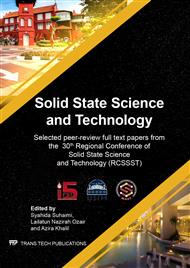[1]
E. Fabbri, D. Pergolesi, and E. Traversa, Electrode materials : a challenge for the exploitation of protonic solid oxide fuel cells,, Sci. Technol. Adv. Mater., vol. 11, no. 44301, p.1–9, (2010).
DOI: 10.1088/1468-6996/11/4/044301
Google Scholar
[2]
S. Wang, F. Zhao, L. Zhang, and F. Chen, Synthesis of BaCe0.7Zr0.1Y0.1Yb0.1O3-δ proton conducting ceramic by a modified Pechini method,, vol. 213, p.29–35, (2012).
DOI: 10.1016/j.ssi.2011.05.014
Google Scholar
[3]
H. Chen and Y. Chen, Hydrothermal Synthesis of Barium Titanate,, Ind. Eng. Chem. Res., vol. 42, p.473–483, (2003).
DOI: 10.1021/ie010796q
Google Scholar
[4]
M. T. Caldes et al., Metallic Nanoparticles and Proton Conductivity: Improving Proton Conductivity of BaCe0.9Y0.1O3−δ Using a Catalytic Approach,, Chem. Mater., vol. 24, p.4641–4646, (2012).
DOI: 10.1021/cm301685x
Google Scholar
[5]
E. Reverchon and R. Adami, Nanomaterials and supercritical fluids,, J. Supercrit. Fluids, vol. 37, no. 1, p.1–22, (2006).
DOI: 10.1016/j.supflu.2005.08.003
Google Scholar
[6]
A. M. Abdalla, S. Hossain, A. T. Azad, and P. M. I. Petra, Nanomaterials for solid oxide fuel cells : A review,, Renew. Sustain. Energy Rev., vol. 82, no. August 2017, p.353–368, (2018).
DOI: 10.1016/j.rser.2017.09.046
Google Scholar
[7]
O. V. Komova et al., A solid glycine-based precursor for the preparation of La2CuO4by combustion method,, Ceram. Int., vol. 41, no. 1, p.1869–1878, (2015).
Google Scholar
[8]
W. Z. W. Zulkifli, N. Osman, and mohd azlan mohd Ishak, Characterization Of Y3+-Doped BaZrO3 Synthesized Using Supercritical Ethanol At Different Reaction Temperature,, Solid State Sci. Technol., vol. 25, no. 2, p.128–133, (2017).
Google Scholar
[9]
K. Takeuchi, J. Guan, S. E. Dorris, and U. Balachandran, The crystal structures and phase transitions in Y-doped BaCeO 3 : their dependence on Y concentration and hydrogen doping,, Solid State Ionics, vol. 138, p.63–77, (2000).
DOI: 10.1016/s0167-2738(00)00771-2
Google Scholar
[10]
K. S. Knight, Powder neutron diffraction studies of BaCe Y O and BaCeO3 0.9 0.1 2.95 at 4.2 K: a possible structural site for the proton,, Solid State Ionics, vol. 127, p.43–48, (2000).
DOI: 10.1016/s0167-2738(99)00269-6
Google Scholar
[11]
D. A. Medvedev, J. G. Lyagaeva, E. V. Gorbova, A. K. Demin, and P. Tsiakaras, Advanced materials for SOFC application: Strategies for the development of highly conductive and stable solid oxide proton electrolytes,, Prog. Mater. Sci., vol. 75, p.38–79, (2016).
DOI: 10.1016/j.pmatsci.2015.08.001
Google Scholar
[12]
A. Kuzmin, V. Balakireva, S. Plaksin, and V. Gorelov, Total and hole conductivity in the BaZr1−xYxO3 system (x = 0.02 − 0.20) in oxidizing atmosphere,, Russ. J. Electrochem., vol. 45, p.1351–1357, (2009).
DOI: 10.1134/s1023193509120064
Google Scholar
[13]
N. Kochetova, I. Animitsa, D. Medvedev, A. Demin, and P. Tsiakaras, Recent activity in the development of proton-conducting oxides for high-temperature applications,, RSC Adv., vol. 6, no. 77, p.73222–73268, (2016).
DOI: 10.1039/c6ra13347a
Google Scholar
[14]
A. K. Azad et al., Structural origins of the differing grain conductivity values in defect association †,, Mater. Chem., p.3414–3418, (2008).
Google Scholar
[15]
K. Katahira, Y. Kohchi, T. Shimura, and H. Iwahara, Protonic conduction in Zr-substituted BaCeO3,, Solid State Ionics, vol. 138, no. 1–2, p.91–98, (2000).
DOI: 10.1016/s0167-2738(00)00777-3
Google Scholar
[16]
C. Hiraiwa et al., Chemical expansion and change in lattice constant of Y-doped BaZrO 3 by hydration/dehydration reaction and final heat-treating temperature,, J. Am. Ceram. Soc., vol. 96, no. 3, p.879–884, (2013).
DOI: 10.1111/jace.12172
Google Scholar


